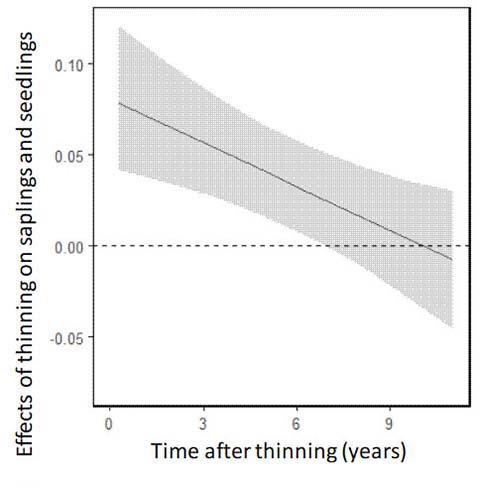Home > Research > Research Results > Research Results 2019 > Meta-analysis of the effects of forest thinning and stand age on forest biodiversity
Update:May 15, 2019
Main content starts here.
Meta-analysis of the effects of forest thinning and stand age on forest biodiversity
| Article title |
Meta-analysis of management effects on biodiversity in plantation and secondary forests of Japan |
|---|---|
| Author (affiliation) |
Rebecca Spake (a), Sakiko Yanou (b), Yuichi Yamaura (c), Kazuhiro Kawamura (d), Kanehiro Kitayama (b), C. Patrick Doncaster (a) (a) School of Biological Sciences, University of Southampton, Southampton, UK. (b) Graduate School of Agriculture, Kyoto University, Kyoto, Japan. (c) Department of Forest Vegetation, FFPRI, Tsukuba, Ibaraki, Japan. (d) Fenner School of Environment and Society,Australian National University, Canberra, Australian Capital Territory, Australia. |
| Publication Journal |
Conservation Science and Practice.2019;e14, March 2019 DOI:10.1002/csp2.14( External link ) |
| Content introduction |
It is recognized that old forests are important from the perspective of forest biodiversity conservation. However, old forests account for only a certain percentage of all the forests in temperate regions, and clarification is needed regarding the benefits of regrown secondary forests and plantations after clearance and the effects of forest management in terms of forest biodiversity conservation. In Japan, which has many secondary forests and plantations, numerous studies have assessed the effects of forest management on biodiversity. Nevertheless, these findings have not been quantitatively summarized. Therefore, in this study, we collected domestic study reports published in Japanese or English that evaluated the relationship between forest management and biodiversity. We then statistically analyzed the data from these studies, focusing on the effects of thinning of plantations as well as the effects of stand age of plantations and secondary forests on the species richness and abundance of individual taxonomic groups. The results indicate that the thinning of plantations increased the species richness and abundance of insects and plants; however, the effects disappeared approximately 6 years after thinning was conducted, indicating the importance of continuous thinning. In addition, the relationship of species richness and abundance with stand age differed depending on the organism groups in both plantations and secondary forests. For example, when the stand age of plantations and secondary forests increased, the species richness and abundance of birds also increased; however, the species richness and abundance of bees decreased. Thus, the value of young or old forests differed depending on the individual taxonomic groups, indicating that the existence of forests with various ages in the landscape is also important. By conducting such studies more systematically in the future, it is necessary to examine the generality and regional differences in forest management and their effects on biodiversity and share the results worldwide.
Figure. Effects of thinning on abundance of saplings and seedlings. |
Copyright © Forest Research and Management Organization. All rights reserved.

